Stretching For Weightlifting: All You Need To Know
Author:
Reviewed by:
(21 years of Oly Lifting experience)
Unlock your full potential by engaging with our experts and community! Have questions about your fitness journey or looking for expert advice on weightlifting techniques? Don’t hesitate — leave a comment below and Sergii Putsov will provide a personalized answer and insights to help you reach your goals.
Torokhtiy is reader-supported. Some links are affiliate links, and we may earn a commission at no extra cost to you. See our disclosure page for details.
What’s the first thing that comes to mind when you think about weightlifting? You probably see barbells, dumbbells, and big, buff guys lifting heavy weights. But there’s one important aspect that doesn’t always get enough attention, and that’s stretching.
Yup, you read that correctly. It might seem like something you would do if you did yoga, but it’s important for lifters, too. Stretching can prevent injuries, improve your performance by increasing flexibility, improve your range of motion, and help with muscle soreness.
But let’s get into more details!
Weightlifting requires significant stretching. And all levels of athletes may benefit greatly from it. Stretching regularly helps reduce muscular imbalances, avoid injuries, enhance training form, and improve weightlifting performance.
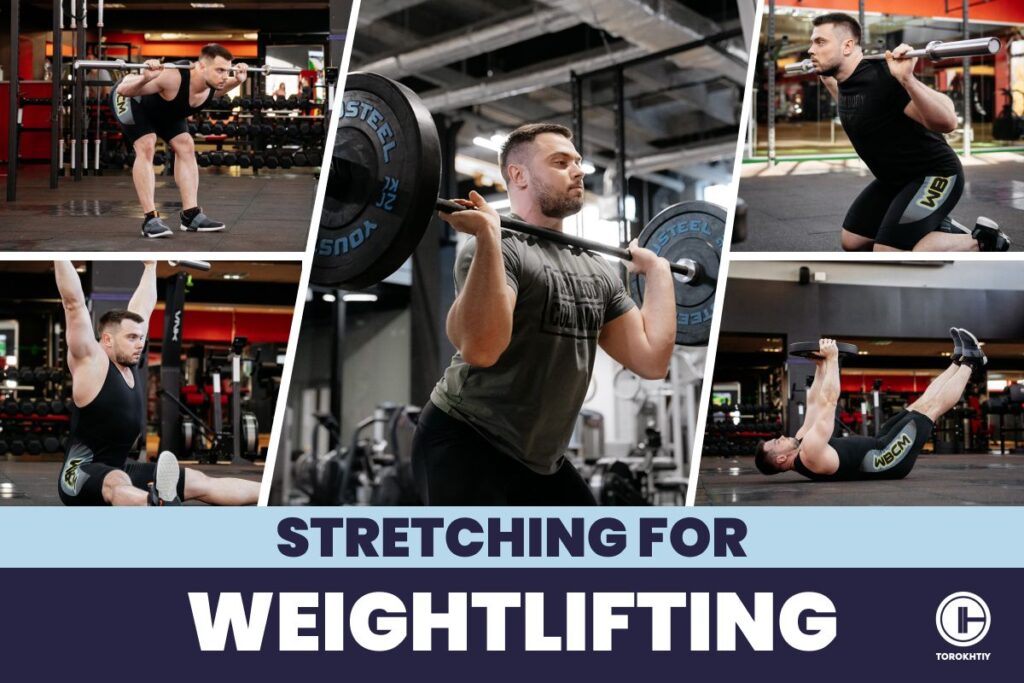
Why Is Stretching Important For Weightlifting?
Everyone who lifts hopes to accomplish their goals without an injury, to feel nice, and, in the long term, to stay as healthy as it possible. This is very realistic; you simply need to keep in mind that, in addition to other physical traits, you also need to stretch and concentrate on flexibility & mobility.
You should deliberately cultivate these skills while taking into account individual peculiarities. The idea that weightlifters simply require strength and that the more strength they have, the more effective they will be is a popular misconception.
Yes, strength and power are crucial, but in order to maximize result potential in Olympic weightlifting, great speed, coordination, agility, and mobility must also be present. If an athlete’s joints lack the requisite ROM and his muscles lack the essential flexibility, even the most talented weightlifter will not be able to execute a snatch correctly & explosively.
Now let’s take a look on benefits of stretching routine for weight lifting. First, we will discuss benefits of stretching for weightlifters before a workout. Stretching before a workout has several benefits. First, it significantly increases blood flow to your muscles and prepares them for the activity to come, and also reduces the risk of injury.
This improved blood flow helps reduce the viscosity of your muscles and makes them more pliable and effective at generating force. Proper stretching improves your range of motion and flexibility, which allows for better posture and technique during lifts.
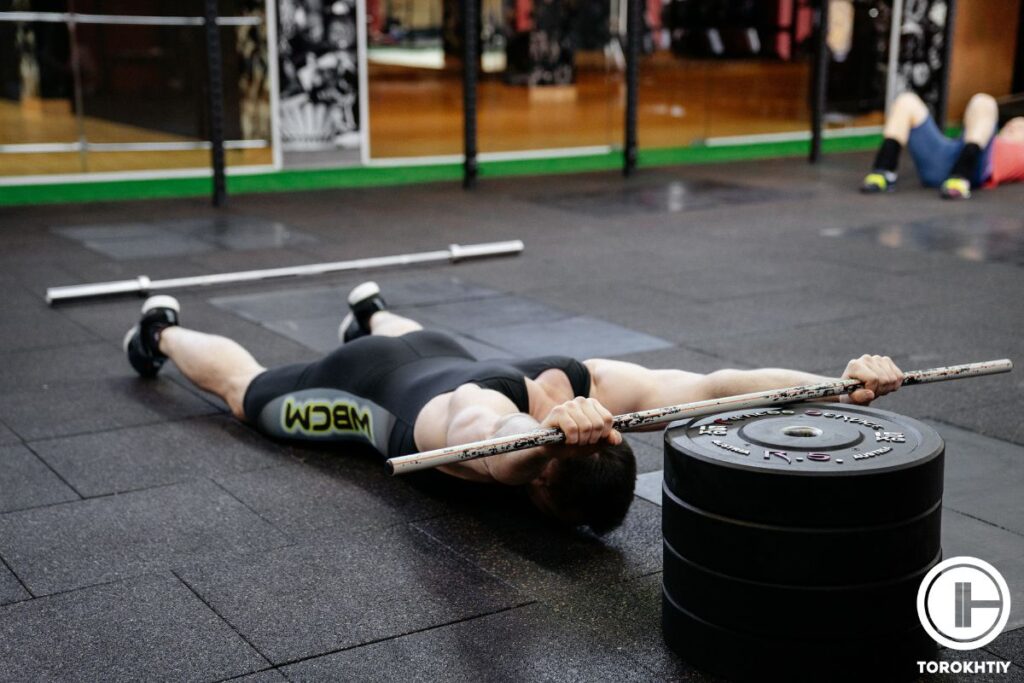
This results in better performance, especially in activities that require agility, speed, and coordination. Be sure that whenever you want to stretch before a workout, don’t spend more than 30-60s in each position as it can have detrimental effects on your performance during that workout.
On the other hand Dynamic stretching, which involves quick, controlled movements, is especially effective before a workout. These movements help prepare your muscles for explosive actions and doing them during morning workouts and after a warm-up can improve your lifting performance a lot.
After working out, you might be inclined to immediately rest, but hold off on getting comfortable and checking your phone! After working out, it’s crucial to stretch for even a little while. Stretch after lifting weights has a number of distinct advantages, including minimizing discomfort and reducing the risk of injury.
Tense muscles are more susceptible to damage, but stretching helps to loosen them and mitigates this risk. Stretching after a workout also helps in the recovery process by flushing out metabolic byproducts and starting muscle repair. This is especially important after intense strength workouts like weightlifting, where muscles can become tight and sore.
Static stretches are ideal after a workout because they help lengthen and relax muscle fibers, relieve spasms, and reduce muscle cramps, spasms, and involuntary contractions. High-intensity or speed-strength activities need prolonged static stretching so that large muscles can recover.
For example, spending about 3 minutes on each leg and arm stretch and four minutes on back and torso stretches can be really beneficial. If you want to dive deeper be sure to check in the Encyclopedia of Neuroscience phenomenon called autogenic inhibition.
The Most Important Stretches
In order to understand how to stretch before lifting, you must first understand what the most effective stretches are, so you don’t waste your time on something you won’t benefit from. Let’s see what those are.
4 Dynamic Stretches
1. Arm Swings
This stretch warms up the shoulder joints and increases blood flow to the upper body and prepares it for the demands of the workout ahead. To do it, stand with your feet shoulder-width apart and swing your arms forward and back in a controlled motion. Increase the range of motion little by little.
2. Leg Swings
Stand next to a wall or support for balance. Swing one leg forward and back, but keep the movement controlled and don’t rely on momentum. Switch legs after 15-20 swings. This exercise will activate hip flexors and hamstrings and enhance the range of motion in the lower body, which is super important for exercises like squats and deadlifts.
3. Torso Twists
Stand with your feet shoulder-width apart and rotate your torso side to side. Your arms should naturally follow the motion. This will warm up your spine and improve rotational flexibility, which is important for maintaining proper posture and form during lifts.
4. Kneeling T-Opener
Get into a quadruped pose with your back in a neutral position, knees under the hips, and wrists under the shoulders. Place one hand on the back of your head. Rotate your torso, guiding as far down into the hand as possible with your eyes, head, and shoulder, then reverse the action, moving your head and shoulder up.
This stretch improves the mobility of the thoracic spine and the flexibility in your shoulders, both of which are important for maintaining a strong, stable lifting posture. 15-20 reps each side will be enough.
5 Static Stretches (time 30-60s in each position before workout BUT 2-3 min after)
1. Sitting Hamstring Stretch
Sit on the ground with one leg extended and the other bent, with the foot near the inner thigh of the extended leg. Lean forward from the hips towards the extended leg and hold the position.
This stretch improves hamstring flexibility and reduces muscle tightness, which improves your ability to perform exercises that need deep knee bends.
2. Pigeon Quad Stretch
This is one of the best stretches for weightlifting that alleviates tightness in the hips and quads, and improves flexibility and mobility that are essential for lower body exercises.
Start in a pigeon pose with one leg bent in front and the other extended behind. Reach back with your arm to grab the ankle of the extended leg and pull it towards your glutes. If you are missing some hip ROM, put the front leg on an incline bench.
3. V Sitting Stretch
This is one of the most popular “lazy” weightlifting stretches. Sit on the ground in a V position with legs extended. Lean forward with a flat back and reach towards your toes. This stretch targets the hamstrings and lower back, improves flexibility and reduces the risk of injury during lifts.
4. Chest Stretch
Stand in a doorway with your arm bent at 90 degrees and place your forearm against the doorframe. lean forward gently to stretch the muscles in your chest.
Stretching the chest muscles improves upper body mobility and posture, which is important for exercises like bench press and overhead press.
5. Leaning Triceps Stretch
Stand with your back against a wall. Raise one arm over your head and bend the elbow, reaching down your back. Use the other hand to gently push the elbow down. This will reduce the tightness in the triceps, which will improve your ability to do overhead lifts and presses with proper form.
Stretching Routine
We’ve answered some really important questions, like “should you stretch before lifting” ,“what stretches to do before lifting weights”, but all of that is of no use if you don’t know exactly how to stretch before lifting. This means knowing exactly what to do, for how long, and when, so let’s get into it.
Follow us!

Free!
Get a 2-week Weightlifting Program as a bonus for the subscription to kickstart your training plan!

Free!
1. Before Weightlifting
I like to categorize mobility into 3 categories: 1. soft tissue mobilization, 2. joint mobilizations and 3. motor control. Before you start your lifting session, you want to address 2 and 3 – ones about movement. Soft tissue mobs can lead to decrease in performance, if performed too long.
Start doing some dynamic stretches that prepare your muscles for the intense activity that’s ahead of you. Start with arm swings to warm up your shoulder joints. Do 2 sets of 15 reps, swinging your arms forward and back in a controlled way.
Follow this with leg swings, which help activate your hip flexors and hamstrings. Do 2 sets of 15 reps per leg and make sure to get a full range of motion. Finish with torso twists to warm up your spine and improve rotational flexibility – 2 sets of 15 reps, rotating your torso side to side.
This routine will improve your blood flow, make your muscles more pliable, and prepare your body for the training session. It can also improve your overall performance and reduce the risk of injuries.
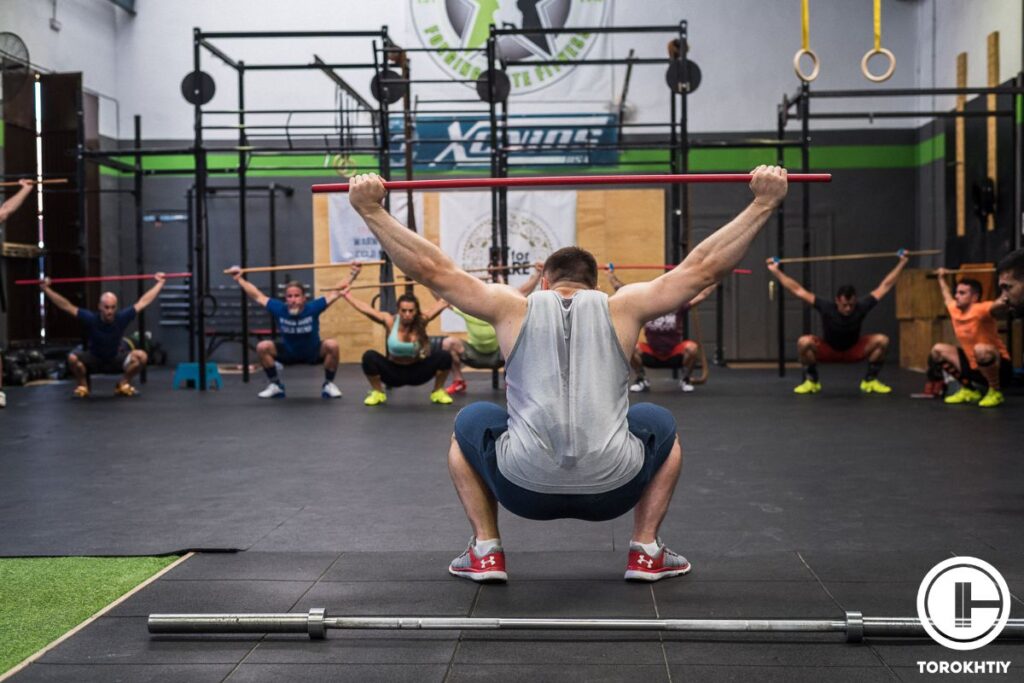
2. After Weightlifting
Once you’re done with your session, you’ll do static stretches to help your muscles recover and reduce the risk of future injuries.
Start with a sitting hamstring stretch and hold this position for 2 minutes to improve the flexibility in your hamstrings. Next is the pigeon quad stretch, and again, you’ll hold the position for about 2 minutes on each side to alleviate the tightness in your hips and quads.
Follow the pigeon quad stretch with the V sitting stretch, sitting with legs extended in a V and leaning forward to stretch the hamstrings and lower back, and then move on to chest stretches. About 2 minutes on each side to enhance upper body mobility, and then you’ll finish with the leaning triceps stretch.
This routine will do wonders in terms of muscle relaxation, recovery, and maintaining flexibility. You’ll be ready for your next workout sooner than you think!
🔻Test Your Mobility Before Starting the Program
Mobility is crucial because it directly impacts your performance, technique, and overall safety.
Complete 3 simple tests to evaluate your current mobility.
Our Program Includes:
- 📺 80 Videos for every exercise:
Unique movements, supported by detailed graphics and voice-over. - 📆 36 Workouts x 30 minutes each:
12-weeks plan can be used as standalone program or as a pre-/post-workout training. - 📊 Tests to track you progress:
Make simple tests in the beginning and after finish to elevate your result. - 🏋️♂️ Made by Olympian:
Designed by a Champion, under the guidance of PhD in sport science and physiotherapist. - 💲One-time payment:
No monthly or any other recurring payments. One payment, life-time usage.
FAQ
How Often Should You Stretch For Weight Lifting?
All healthy people, including Olympic weightlifters, should perform stretching and flexibility drills for all significant muscle groups at least twice to three times each week. Each stretching exercise has to be done for a total of 40-60 sec for best effects.
Is Static Stretching Good For Weightlifting?
Static stretching is recommended after an Olympic weightlifting workout to lessen muscle discomfort and improve the recovery process. Dynamic stretching should be used to better prepare lifters before training because static stretching can have a negative impact on performance.
What Happens If You Don’t Stretch Before Lifting Weights?
Your body will be more sensitive to pain and tension in the muscles. Your muscles stiffen up if you don’t stretch regularly. Your muscles will eventually strain on your joints, resulting in movement limitations, discomfort and lack of mobility.
Conclusion
Systematic stretching allows us to move comfortably and safely. When stretching, you need to pay attention to the fact that sometimes it’s not the muscle flexibility that is missing and not allowing you reach desired positions.
Sometimes it’s about joint mobility or stability, sometimes both. some joints need mobility more than stability, while others need it the other way around. Competent routine before and after lifting session is a combination of mobility, flexibility and stability in the right proportion.
Now it’s your turn! Which stretching drill is more attractive to you? Tell me about it all in the comments!
References:
- Autogenetic Excitation and Inhibition of Motoneurons. In: Binder, M.D., Hirokawa, N., Windhorst, U. (eds) Encyclopedia of Neuroscience. Springer, Berlin, Heidelberg. https://doi.org/10.1007/978-3-540-29678-2_457 2008.
- Photos are made by Torokhtiy Media team.
Also read:
Why Trust Us?
With over 20 years in Olympic weightlifting, strength training, nutrition coaching, and general fitness our team does its best to provide the audience with ultimate support and meet the needs and requirements of advanced athletes and professional lifters, as well as people who strive to open new opportunities and develop their physical capabilities with us.
By trusting the recommendations of our certified experts in coaching, nutrition, and sports training programming, as well as scientific consultants, and physiotherapists, we provide you with thorough, well-considered, and scientifically proven content. All the information given in the articles concerning workout programming, separate exercises, and athletic performance, in general, is based on verified data.
The product testing process is described in more detail here.
Author: Sergii Putsov
Head of Sport Science, PhD
Best Results: Snatch – 165 kg,
C&J – 200 kg
Sergii Putsov, Ph.D., is a former professional weightlifter and National team member, achieving multiple medals in the 94 kg weight category at national competitions. With a Master’s degree in “Olympic & Professional Sport Training” and a Sport Science Ph.D. from the International Olympic Academy, Greece, Sergii now leads as the Head of Sport Science. He specializes in designing training programs, writing insightful blog articles, providing live commentary at international weightlifting events, and conducting educational seminars worldwide alongside Olympic weightlifting expert Oleksiy Torokhtiy.
Reviewed by: Oleksiy Torokhtiy
Olympic Weightlifting Champion, PhD in Sport Science
Best Results: Snatch – 200 kg,
C&J – 240 kg
Oleksiy Torokhtiy is a professional athlete boasting 20 years of experience in Olympic weightlifting. With multiple European and World titles under his belt, he has showcased his prowess in two Olympic Games (Beijing 2008 and London 2012). Upon concluding his illustrious career, Oleksiy dedicated himself to coaching. By 2022, he had conducted over 200 weightlifting seminars worldwide. He is the visionary behind an international sportswear and accessories brand known for its motto, “Warm Body Cold Mind.” Additionally, he is an esteemed author and the creator of a series of training programs and eBooks.




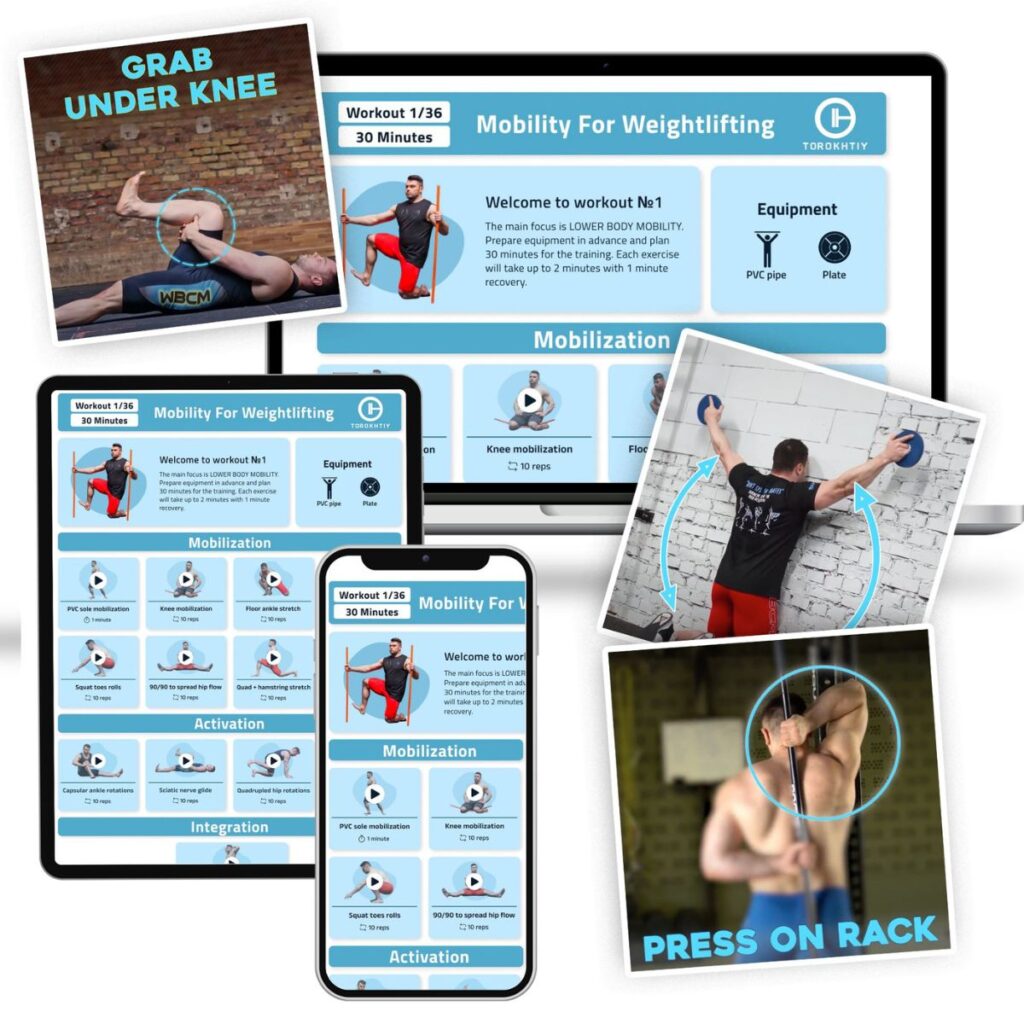
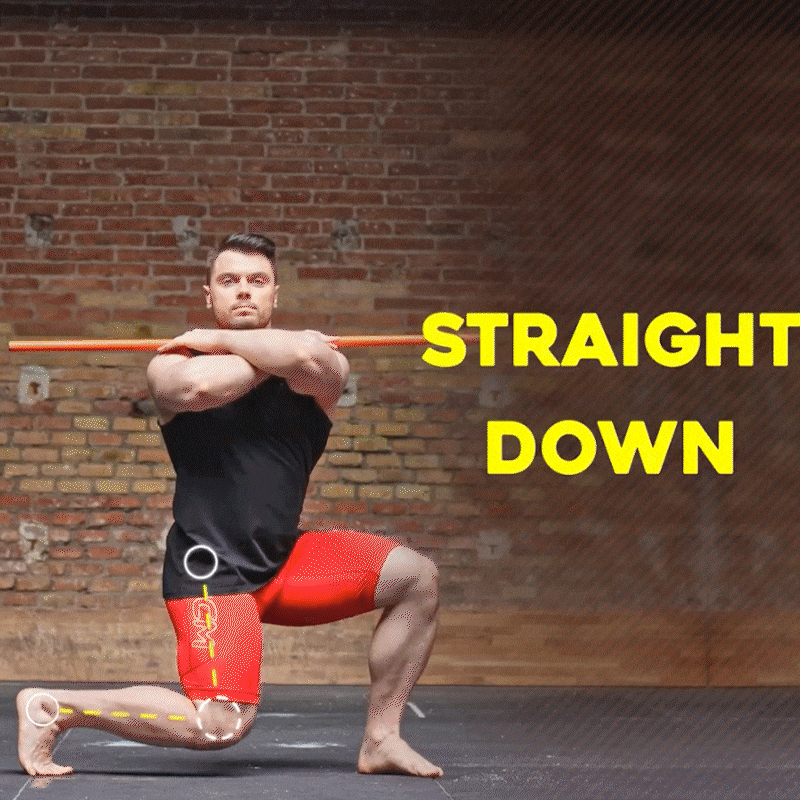
Still have questions after reading our article? Unlock your full potential by engaging with our experts and community! Don’t hesitate — leave a comment below and Sergii Putsov will provide a personalized answer and insights to help you reach your goals.